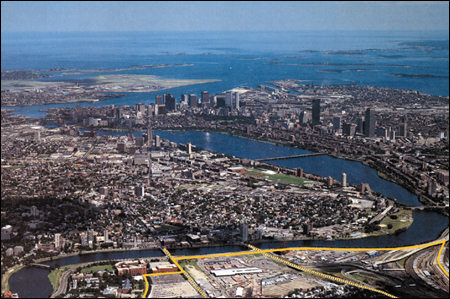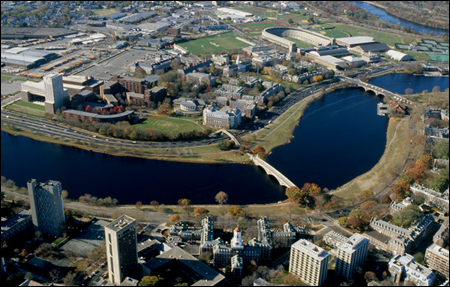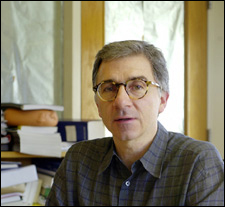Harvard faculty brings Allston into focus
Task force members envision academic future
ALLSTON: PROGRESS REPORT OF THE FACULTY TASK FORCES 2004

A vision of Harvard a half-century from now is beginning to emerge with preliminary ideas and options proposed by nearly 70 faculty members serving on four Allston task forces.
Offering a first glimpse of Allston’s potential from the perspective of Harvard
See the special Gazette Allston section
faculty, the task force reports point to Allston as a catalyst for academic collaboration and innovation and as an engine for cultural and community vitality. The reports represent the first of many steps that will help shape Harvard in the decades to come and bring broader benefits to the Allston community.
“The breadth and depth of thinking in these reports underscore the willingness of people from across Harvard to think boldly and enthusiastically about Allston,” said Harvard University President Lawrence H. Summers. “We look forward to continuing broad discussions within the University in the months ahead as we engage a planning firm to consider how these ideas might be translated into first phase physical plans, and as we carry forward our close collaboration with Mayor Menino and the Allston community on this exciting project that holds so much promise for Harvard and the City of Boston.”
Instead of looking at Allston as a collection of land parcels on which specific structures might be built, faculty envisioned the lives of future undergraduates, the changing educational needs of professionals, the lightning-speed evolution of new scientific disciplines, and the ever-growing need for meaningful connections among communities.
The faculty reports – while grounded in data and taking into account existing physical conditions – offer a range of options identified as possible scenarios; task force members did not limit themselves in generating ideas around the question: “What is the best thing we can do to advance our academic missions?”
“Collectively, as a University, this is our chance to reshape the Harvard experience – not just for ourselves, but for generations to come,” said William C. Kirby, dean of the Faculty of Arts and Sciences and Geisinger Professor of History.

One researcher on the Science and Technology Task Force excited by the possibilities was Doug Melton, Thomas Dudley Cabot Professor of Natural Sciences. “As a member of the task force I was delighted by the range of proposals from across the University, which showed real imagination in pushing the boundaries of science. The kinds of collaborative ventures that were discussed are just the kind of initiatives that we hope to see in Allston one day. Of the 70 proposals we received we now have a range of ideas that will be considered.”
The task forces looked at how Allston might accommodate and ultimately enhance teaching and learning, and Harvard campus life in the future, and offered a range of potential options:
- The Science and Technology and Professional Schools reports each envision scenarios that would enable faculty to expand interdisciplinary collaboration and strengthen leadership in the professions.
- The Science and Technology report outlines a list of emerging areas of interest in the sciences that might be pursued in Allston.
- The Professional Schools report analyzes ways that interdisciplinary learning can be fostered among all professional Schools, describes ways that a shared conference center could be developed, and discusses a range of strategic choices for the Graduate School of Education and the School of Public Health that could facilitate an eventual relocation in Allston.
- The Undergraduate Life report underscores the benefits of an eventual undergraduate presence in Allston, and outlines the potential shape of that presence, including options for undergraduate Houses, and academic opportunities in the sciences and professional Schools.
- Both the Allston Life Task Force and Undergraduate Life Task Force reports offer different ways to cultivate a vibrant, integrated, mixed-use campus, with cultural and performing arts venues, housing, retail, as well as transportation improvements to serve both the student body and the neighboring community.Speaking about the process, which represents a new University-wide approach to Harvard planning, Josh Basseches, executive director of the Harvard Museum of Natural History, and an ex officio member and staff to the Culture Subcommittee, said, “When we started, we said very strongly that we don’t simply want to think about what doesn’t fit here in Cambridge. Instead, we wanted to look beyond the current ways of doing things and ask ‘How can we do them better?’”The reports are the result of four months of intense collaboration among task force members, with input from the broader University community. Each progress report provides a number of options to consider around one of four key themes proposed by President Summers in a letter to the Harvard community in October 2003. The findings flesh out those ideas so that Harvard can begin the process of refining the campus elements that will ultimately be located in Allston.
In anticipation of future space needs, universities and institutes around the country are either acquiring new property or planning for new satellite campuses

‘As a member of the task force I was delighted by the range of proposals from across the University, which showed real imagination in pushing the boundaries of science. The kinds of collaborative ventures that were discussed are just the kind of initiatives that we hope to see in Allston one day. Of the 70 proposals we received we now have a range of ideas that will be considered.’ – Douglas Melton, Thomas Dudley Cabot Professor of Natural Sciences
or campus extensions. With nearly 200 acres of land in Allston, much of it consisting of vacant warehouses, industrial uses, and rail yards, Harvard is in a unique position to think very long range, laying the framework today for the Harvard of decades from now as both sides of the Charles River merge into one campus.”Harvard has, by its history, always been striving to be a leader in the critical areas of knowledge, and we would be abdicating our role as intellectual leaders if we didn’t do everything in our power to make it possible for our faculty to move into new areas or approach teaching and research in new ways,” said Provost Steven Hyman, chair of the Science and Technology Task Force. “In the meantime, we have an obligation to preserve knowledge, which means keeping traditional academic fields, such as the classics and ancient languages, alive for future generations.”
Harvard faculty see the enormous potential for Harvard’s Allston land to prepare for the needs and expectations of society tomorrow and contribute to the vitality of the neighboring community.
“We have tried to present some conceptual frameworks to help plan for an integrated campus – an extension of Harvard in Allston,” said Dennis Thompson, professor of government and chair of the University Physical Planning Committee, who also chairs the Allston Life Task Force. “We do not want to establish a satellite campus in Allston, but rather to create a single campus in which the river is an attractive center rather than a forbidding obstacle. Equally important, Allston should provide an environment that is welcoming to Allston’s longtime residents, as well as its new residents who will include members of the Harvard community.”
“Harvard’s opportunity in Allston is extraordinary: to create from the start a 21st century university environment that is innovative, serves complementary and diverse interests, and enhances the City of Boston,” said Allston Life Task Force member Jerold Kayden, Frank Backus Williams Professor of Urban Planning and Design. “Who could not be both inspired and humbled by this opportunity?”
“Everyone involved in this process has taken an incredibly long-term outlook,” said George Baker, Herman C. Krannert Professor of Business Administration, a member of the Allston Life Task Force, and chair of its Transportation Subcommittee. “The planning process rarely looked out less than 10 years, and often looked out 50 years. With an opportunity this great, and with the potential impact so huge, we felt that it was foolish to be too swayed by short-term considerations. One of the sobering aspects of this very long-term perspective has been the recognition that we are proposing and evaluating options, some of which are unlikely to be realized in our lifetimes! It makes me want to live a long life so that I can see how this all turns out.”
The core findings of each report can be found in separate articles; full copies and executive summaries of the reports are available on the Web at http://www.allston.harvard.edu/envisioning/tfintro.htm.




